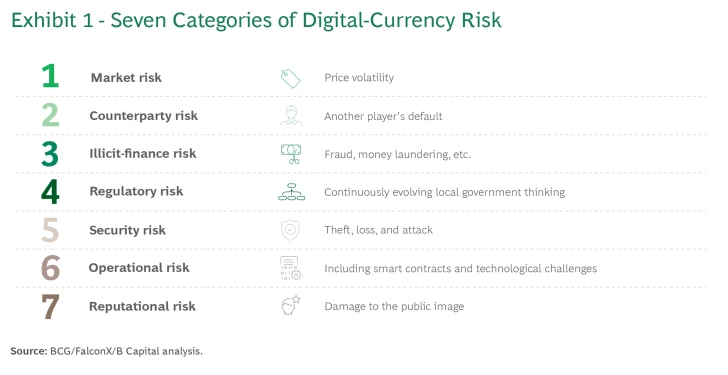Digital currencies including cryptocurrencies, stablecoins and central bank digital currencies (CBDCs), have grown tremendously over the past years, attracting investors and financial services customers for their ability to hold and transfer value without needing a central authority to validate and process transactions.
As innovation in the financial services sector accelerates and as adoption of digital assets continues to rise, financial institutions need to adapt and offer asset-specific offerings, capabilities, and safeguards for digital currencies, similar to other asset classes, a new report by the Boston Consulting Group (BCG) says.
But in order to fully take advantage of this opportunity, financial institutions must understand the risks associated with digital currencies and implement the right tools to mitigate those risks.
In a new report, titled Managing Risk for the Next Wave of Digital Currencies and released in July 2023, the consulting firm outlines the risks that come with supporting and offering digital currencies, as well as the appropriate tools and methods to mitigate them.
Risks associated with digital currencies
BCG outlines seven main risks relating to digital currencies. The first risk involves price volatility and the risks of speculative bubbles and market-driven price crashes. Even stablecoins, which are tied to fiat-currency values and backed by collateral, can be volatile, especially when the collateral is inadequate, insufficient or algorithmic, the report says. Unlike the traditional financial market, the digital currency market lacks the controls that traditionally protect participants from extreme volatility and from borderline-illegal market swings, such as pump-and-dump schemes.
The second risk relating to digital currencies are counterparty risks. Digital currencies are similar to non-transparent illiquid assets. Moreover, while they are decentralized in design, liquidity is channeled via a limited group, especially digital currency exchanges, which can be subjected to significant challenges, including poor internal controls and trading failures, sometimes leading to bankruptcy. If exchanges or digital currency holders default, a digital currency’s value can plummet quickly, the report warns. Such losses can cause widespread volatility, impacting other assets.
The third risk outlined is the risk of illicit-finance, fraud, price manipulation and deceptive activity. Practices like “rug pulls”, where a developer launches and hypes a cryptocurrency project to attract investment and then suddenly abandons the project and disappears with the funds, are similar to conventional pump-and-dump schemes and have become rampant. Because of the cross-jurisdictional nature of digital currencies, the market does not have the same level of protections and controls than those in the financial services industry, exposing clients to higher risks of fraud.
The fourth risk relates to security. Digital currencies, when not adequately secured, are prone to theft, loss, and cyberattacks. In 2022, a staggering US$3.8 billion was stolen from digital currency businesses, especially from decentralized finance (DeFi) protocols, according to blockchain analysis firm Chainalysis. Criminals may steal or deplete digital-currency holdings, and they may also capture private keys. If private keys, passwords, or wallets are stolen or lost, their value may be unrecoverable, the report warns. Unlike with other asset classes, banks have limited recourse to support customers. Most of them only provide custody to safeguard the key to the holdings.
The fifth risk outlined in the report is regulatory risk. Governments globally are actively developing new regulations for digital currencies. This constantly evolving regulatory landscape means that the cost of servicing digital currencies will continue to rise and that compliance experts must pay close attention to shifts in direction.
The sixth risk relating to digital currencies is operational risk. Digital currencies are inherently more complex than traditional value storage and transfer methods. With the exception of popular decentralized cryptocurrencies like Bitcoin, digital currencies are typically supported by founding companies with complex and somewhat opaque governance structures, such as decentralized autonomous organizations (DAOs). They may also involve novel technologies and behavioral patterns, which can make understanding value evolution and trade consequences challenging to some investors. Another operational risk is errors in smart contracts, which are automated agreements on the blockchain. A mistake in the drafting and coding of that contract could lead to unintended transactions and result in significant losses without recourse.
Finally, the seventh risk outlined in the report is reputation risk. Unlike fiat currencies, the stability of a digital currency isn’t tied to a country’s performance. Hence, various events, including a vendor’s sudden collapse, scams, Ponzi schemes and malware attacks, may cause reputational harm to the market, the report warns.

Seven categories of digital currency risks, Source: Managing Risk for the Next Wave of Digital Currencies, Boston Consulting Group, July 2023
Mitigating digital currency risks
To mitigate these risks, banks should put in place a comprehensive set of risk-mitigation strategies and measures, BCG says.
At the investment-level, banks should adopt blockchain intelligence capabilities to detect and mitigate illicit-finance and counterparty risks.
Some third-party vendors offer increasingly sophisticated artificial intelligence (AI)-based tools and analytic practices for monitoring digital currencies’ blockchain transactions, the firm says. These systems are capable of detecting patterns in transaction histories that are consistent with money laundering or illicit finance, and are often connected with law enforcement, regulators and compliance officers.
Banks should also conduct proper asset research, closely examining the business fundamentals of the digital currency and its sources, the financial health of the firm, its software and agreement architecture, its balance-sheet structure, provenance, and business model.
They should also thoroughly assess their vendor and partner relationships to make sure that these companies are reliable and trustworthy.
But above all, banks must continuously improve their functional capabilities, and align them with their digital currency strategy and risk appetite. As new aspects of digital currency technology appear, and as risk-mitigation techniques evolve, such as protocols, blockchain innovations, or software bridges, banks will need to experiment with them.
Financial institutions can also raise their capabilities by instituting company-wide guidelines that specify approved practices for digital-currency offerings, by developing appropriate communications and compliance policies, and by considering insurance lines.

Strategies for Mitigating Investment Risks, Source: Managing Risk for the Next Wave of Digital Currencies, Boston Consulting Group, July 2023
Featured image credit: Edited from freepik






